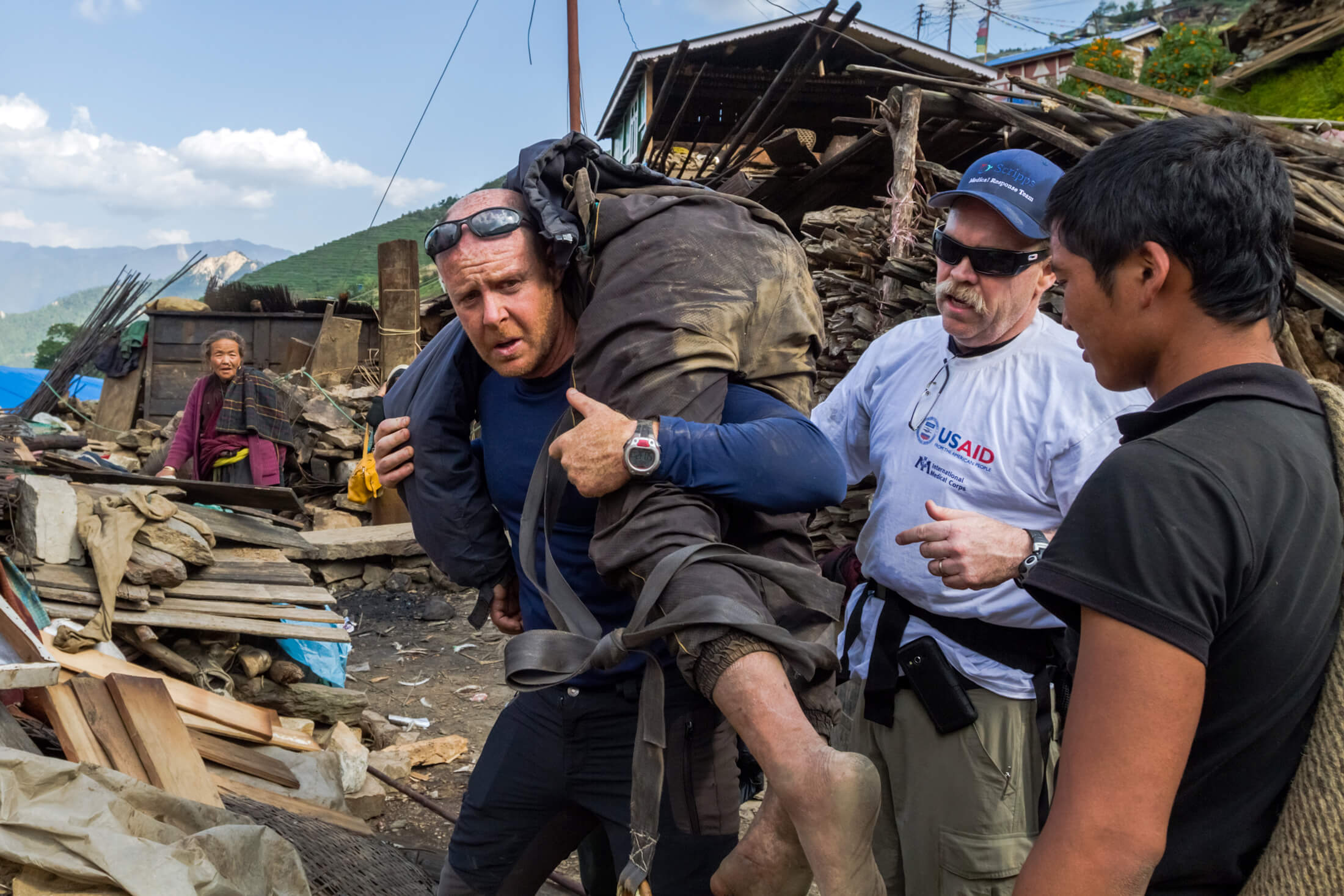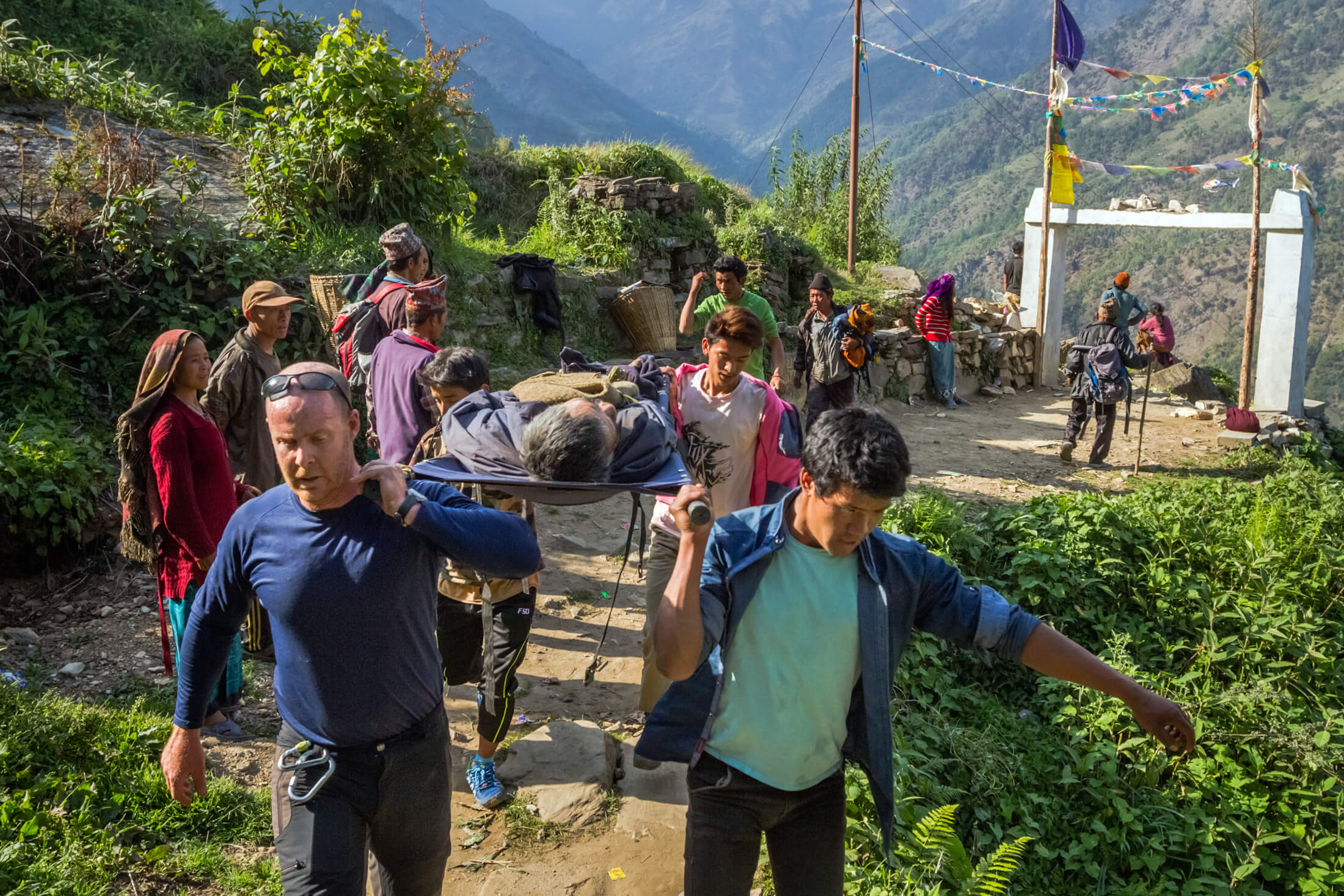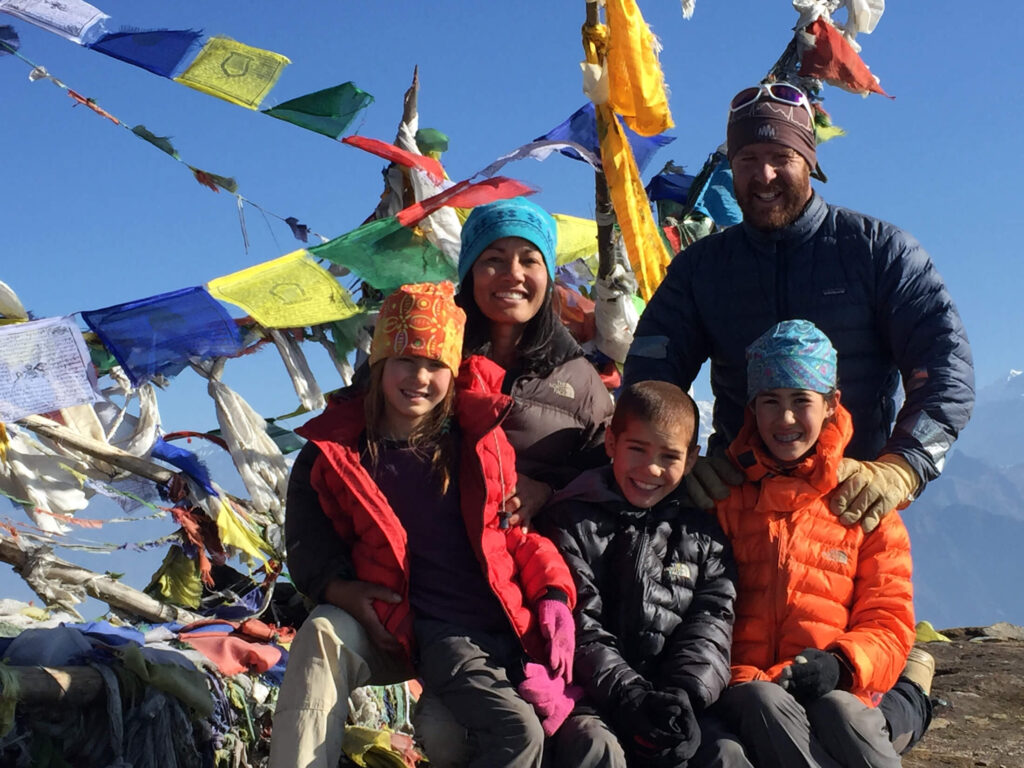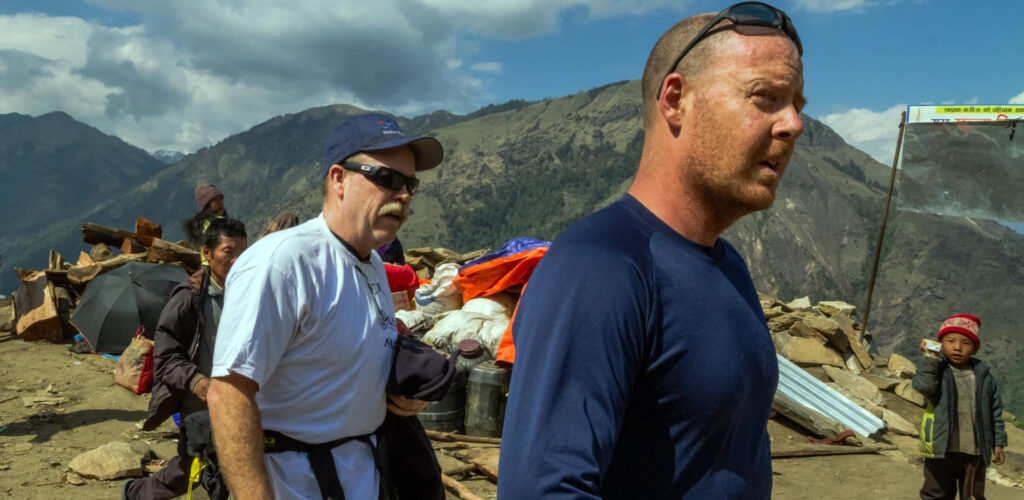As we reflect on International Medical Corps’ 40-year history, we’re highlighting some of the courageous volunteers and staff members who have dedicated their lives over the years to helping others. This profile of Dr. Michael Karch is the first in that series.
When planes hit the World Trade Center in New York on September 11, 2001, Dr. Michael Karch didn’t hesitate—he acted. What he didn’t anticipate was how this would change the trajectory of his career and help him find his purpose. Eventually, this journey led him to volunteer with International Medical Corps in Nepal as part of our earthquake response in 2015.
“The morning of September 11, 2001, was an awakening. I was in my seventh year of residency at Georgetown University when we heard that the Pentagon had been attacked,” explains Dr. Karch. “We were told that we were going to receive between 100 and 200 patients, and in fact, we only got one patient because all the bridges were shut down to protect the city. Then I did something radical— I went home and packed a backpack with some emergency supplies. I took a cab from Washington, D.C. to Baltimore…and I got the last train from Baltimore to New York.”
When he arrived, Dr. Karch helped set up the first mass casualty center at Ground Zero.
“Ground Zero was like nothing I had ever seen,” he remembers. “It was hot. It was incredibly dusty. You couldn’t breathe. It was suffocating. There was just mass destruction everywhere—exploding gas lines, electrical lines that were alive. It was a very dangerous situation. There was no order. There was no leadership. There was no set of rules or protocols. We had to make them up on-the-ground. That was very difficult, but at the same time, I think people just rise to the challenge. What I saw at Ground Zero was one of the worst events in our history, but what I saw was some of the best human efforts.”
Dr. Karch spent the next 48 hours treating patients at Ground Zero, and it became clear how much he needed to learn. Practicing medicine in a low-resource environment or disaster area with hundreds or even thousands of casualties requires an expertise he had yet to acquire.
“It was a real awakening for me,” he continues. “I spent the next 10 years studying mass casualty medicine, including what was going on in the Iraqi and Afghanistan wars and what we were learning over there. I really focused on how to most effectively treat a large number of patients that are exposed to a bomb or a disaster or any such event.”
The desire to learn and to help people was something he recognized in himself at an early age. Growing up in rural Pennsylvania, Dr. Karch worked on small farms and learned how communities connect and grow together.


“I had this desire to help people—and medicine, but specifically orthopedic surgery, really is that perfect combination of using your hands to fix things and to innovate, and at the same time to help people,” he explains from his home in Mammoth Lakes, California, where he has been an orthopedic surgeon for more than 20 years.
Dr. Karch completed his undergraduate studies at the University of Delaware and then went to the Georgetown University School of Medicine. After earning his medical degree, he stayed at Georgetown for another 11 years, completing his surgery residency there. After that, he did a fellowship in sports medicine in Taos, New Mexico, and then completed some additional training in joint replacement, surgery and fracture.
An Awakening in Nepal
In April 2015, when an 8.1 magnitude earthquake hit Nepal, Dr. Karch once again didn’t hesitate. He signed up as a volunteer with International Medical Corps and went to where our team was mounting an emergency response. The earthquake was the worst the country had experienced in more than 80 years: more than 3,800 people were killed, and more than 7,100 were injured.
“I arrived in Nepal in 2015, just after the earthquake hit. One of my roles [with International Medical Corps] during that time was to get on a helicopter with a team, and we would go from small town to small town. These towns were incredibly remote, often connected only by footpath and 30 to 50 miles away from a dirt road.”
On one of these trips, Dr. Karch and an International Medical Corps team went to a remote village in the Annapurna region on a reconnaissance mission to gather information and mount an effective response.
“We flew over this destroyed village, and then we landed 2,000 feet up on the mountainside… An elderly-looking woman came up to us and said, ‘My husband is trapped down in the village 2,000 feet below us. He’s been hit by rockfall. He’s paralyzed. Can you save him?’”
The team knew they had to help, but it was getting dark, and they needed the time and visibility to get back to the base safely.
“We started running down the mountainside, and it was about 45 minutes before we got in, and he was paralyzed. He was trapped… I picked him up in a fireman’s carry and started carrying him. His weight was incredibly oppressive, especially at 13,000 feet… and I made it about 20 steps. Then I traded him off to my partner, another volunteer who was an EMT from San Diego, and he took him about another 20 steps, and then I took him 20 steps.”

They went back and forth for a while, and it became clear that they wouldn’t make it back to the helicopter in time. As they traveled uphill, villagers saw what was happening and gathered to help. Looking back, it’s evident that Dr. Karch can still feel the collective energy and awakening from that day.
“First, it was two people, and then it was four people, and then it was eight people,” he remembers. “You could see the villagers being awakened…They disappeared around the corner, moving up toward the helicopter. And I think at that time, I realized I was getting older. I realized that my strength didn’t compare at all to the strength of the group.”

Eventually, the team made it back to the helicopter and evacuated the injured man, Madhira Singh, to Gorkha District Hospital for advanced medical care.
“Our legacy as humans is not to destroy,” Dr. Karch continues. “It’s not to fight. It’s not to pollute. Our legacy is really to help each other so that everyone around us is better—everyone around us is more positive, everyone around us is more whole.”
After volunteering with International Medical Corps, he returned home to California, but the experience stuck with him. As a long-time medical practitioner and volunteer in disaster areas, Dr. Karch recognizes the importance of the role.
“The role of volunteers is to start the process of rebuilding and take that destruction and create that rebirth and cause a bit of an awakening,” Dr. Karch explains. “I think there’s a tremendous amount of guilt that at least I feel, and I know others do, too, when it comes time to go home—because the job’s not done yet, and there’s so much more to do. But the great thing about organizations like International Medical Corps is that even though the individual volunteers may be there for a set amount of time, the organization is there for much longer.”
Treating the Unseen Wounds of Disaster Response
When asked how disaster medicine has evolved during the time he’s been involved, Dr. Karch points to the importance of addressing the unseen wounds of disasters and the attention to mental health that is needed to begin that healing process.
“At Ground Zero, we were focused on getting people out alive,” he says. “We had no idea—or, at least, I’ll speak for myself, I had no idea—of the mental toll that would take on people for years to come. As we would treat a broken leg, as we would treat a laceration, we need to treat the mental state more acutely as well.
“And then we need to talk about the mental health of the healthcare providers,” he continues. “You go from a disaster zone, and then you fly on a 12- or 17-hour-long flight, and you are thrust back into your normal life, with normal work and family expectations. That’s quite difficult. You go home to the dinner table, and your kids are wasting food, and that’s a really difficult thing to comprehend. I think that some kind of decompression time between the disaster zone and regular life is needed.”
Making a Difference, Wherever You Are
The challenges of volunteering in a disaster zone, including the mental toll, can seem quite daunting. Not everyone has the time or capacity for that kind of commitment—but there are many ways to make a lasting, positive impact in your community, he says.
“Everybody can make a difference,” Dr. Karch explains. “You don’t have to fly on an airplane to Nepal and carry a man out of a disaster to make an impact. You could volunteer in your community. You could mentor someone. You could teach. You could coach. You could be nice to somebody. It doesn’t take much to start that ball of positivity rolling, and that creates a ripple effect.”

Having volunteered with several organizations over the years, Dr. Karch draws on his wealth of experience working in disaster zones when asked about his time with International Medical Corps.
“My time spent with International Medical Corps was probably one of the best experiences I’ve had,” he says. “International Medical Corps is extremely organized in a striking way. They’ve got an incredible number of contacts on the ground, equipment and resources. It just seemed to me that a lot of the obstacles, barriers and bureaucracy that I had seen in other disaster zones, I didn’t really encounter with International Medical Corps, and that was quite refreshing. I could go there and just do what I was supposed to do—be a doctor.”
Dr. Michael Karch is a surgeon, entrepreneur and author of the new book, TANGIBLE HEROES: The Force Multiplying Power of Ordinary People with Extraordinary Impact.
Learn more about our mental health and psychosocial support (MHPSS) programs and ongoing psychological first aid (PFA), including PFA training for caregivers in Ukraine.
